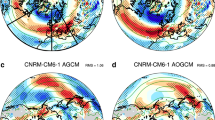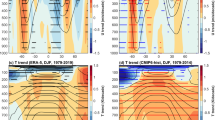Abstract
The polar-to-subtropical temperature gradient in the free troposphere is a key driver of the extratropical jet stream response to climate change. Climate models tend to steepen this gradient in response to large greenhouse gas increases, due to very strong subtropical upper-level warming. This strengthens the simulated jets. However, multiple lines of observational evidence point to a slowing northern jet over the satellite era, driven by enhanced Arctic free-tropospheric warming and weakening of the gradient. Here, we reconcile these seemingly contradictory results by showing that the CMIP6 ensemble successfully simulates both the observed satellite-era slowdown/weakening, and the speedup/strengthening with strong global warming. Specifically, the observed gradient weakening from 1980–1997 to 1997–2014 appears inconsistent (p < 0.05) with the simulated gradient changes for just 6 of 45 models using Microwave Sounding Unit observations, and for just 5 of 45 models using reanalysis estimates. The observed jet slowdown appears inconsistent with the simulated jet changes for just 1 of 45 models. In fact, a clear majority of the CMIP6 models weaken the gradient and slow down the jet over this interval. Yet a strong majority of the models reverse course under a high-emissions future-type scenario, simulating gradient strengthening and jet speedup. Future work will seek to clarify the cause(s) of this unexpected difference between past and future atmospheric responses.





Similar content being viewed by others
Data availability
All CMIP5 data is publicly archived and available at https://esgf-node.llnl.gov/search/cmip5/. All CMIP6 data is publicly archived and available at https://esgf-node.llnl.gov/search/cmip6/. All reanalysis data used in this study is archived and available at https://esgf-node.llnl.gov/search/create-ip/. The synthetic MSU data from Po-Chedley et al. (2021) is available at https://pcmdi.llnl.gov/research/DandA/PNAS_2021/index.html.
References
Allen RJ, Sherwood SC, Norris JR, Zender CS (2012) The equilibrium response to idealized thermal forcings in a comprehensive GCM: implications for recent tropical expansion. Atmos Chem Phys 12:4795–4816. https://doi.org/10.5194/acp-12-4795-2012,2012
Barnes EA, Polvani LM (2013) Response of the midlatitude jets, and of their variability, to increased greenhouse gases in the CMIP5 models. J Clim 26:7117–7135. https://doi.org/10.1175/JCLI-D-12-00536.1
Barnes EA, Polvani LM (2015) CMIP5 projections of Arctic amplification, of the North American/North Atlantic circulation, and of their relationship. J Clim 28:5254–5271. https://doi.org/10.1175/JCLI-D-14-00589.1
Barnes EA, Screen JA (2015) The impact of Arctic warming on the midlatitude jet-stream: Can it? Has it? Will it? Wires Clim Change 6:277–286. https://doi.org/10.1002/wcc.337
Barnes EA, Dunn-Sigouin E, Masato E, Woolings T (2014) Exploring recent trends in Northern Hemisphere blocking. Geophys Res Lett 41:638–644. https://doi.org/10.1002/2013GL058745
Berrisford P, et al (2011) The ERA-Interim archive version 2.0. ERA report series. https://www.ecmwf.int/en/elibrary/73682-era-interim-archive-version-20. Accessed 30 December 2022
Bonan DB et al (2018) Sources of uncertainty in the meridional pattern of climate change. Geophys Res Lett 45:9131–9140. https://doi.org/10.1029/2018GL079429
Butler AH, Thompson DWJ, Heikes R (2010) The steady-state atmospheric circulation response to climate change-like thermal forcings in a simple general circulation model. J Clim 23:3474–3496. https://doi.org/10.1175/2010JCLI3228.1
Ceppi P, Hartmann DL (2016) Clouds and the atmospheric circulation response to warming. J Clim 29:783–799. https://doi.org/10.1175/JCLI-D-15-0394.1
Delcambre SC, Lorenz DJ, Vimont DJ, Martin JE (2013) Diagnosing northern hemisphere jet portrayal in 17 CMIP3 global climate models: twenty-first-century projections. J Clim 26:4930–4946. https://doi.org/10.1175/JCLI-D-12-00359.1
Deser C, Tomas RA, Sun L (2015) The role of ocean–atmosphere coupling in the zonal-mean atmospheric response to Arctic sea ice loss. J Clim 28:2168–2186. https://doi.org/10.1175/JCLI-D-15-0394.1
Ding Q, Schweiger A, L’Heureux M et al (2019) Fingerprints of internal drivers of Arctic sea ice loss in observations and model simulations. Nature Geosci 12:28–33. https://doi.org/10.1038/s41561-018-0256-8
Eyring V et al (2016) Overview of the coupled model intercomparison project phase 6 (CMIP6) experimental design and organization. Geosci Model Dev 9:1937–1958. https://doi.org/10.5194/gmd-9-1937-2016
Fasullo JT et al (2022) Spurious late historical-era warming in CESM2 driven by prescribed biomass burning emissions. Geophys Res Lett 49:2. https://doi.org/10.1029/2021GL097420
Feldstein SB, Lee S (2014) Intraseasonal and interdecadal jet shifts in the northern hemisphere: the role of warm pool tropical convection and sea ice. J Clim 27:6497–6518. https://doi.org/10.1175/JCLI-D-14-00057.1
Francis JA (2017) Why are Arctic linkages to extreme weather still up in the air? Bull Am Meteor Soc 98:2551–2557. https://doi.org/10.1175/BAMS-D-17-0006.1
Francis JA, Vavrus SJ (2012) Evidence linking Arctic amplification to extreme weather in mid-latitudes. Geophys Res Lett 39:L06801. https://doi.org/10.1029/2012GL051000
Francis JA, Vavrus SJ (2015) Evidence for a wavier jet stream in response to rapid Arctic warming. Environ Res Lett 10:014005. https://doi.org/10.1088/1748-9326/10/1/014005
Fu Q, Johanson CM (2005) Satellite-derived vertical dependence of tropical tropospheric temperature trends. Geophys Res Lett 32:10. https://doi.org/10.1029/2004GL022266
Fu Q, Johanson CM, Warren SG, Seidel DJ (2004) Contribution of stratospheric cooling to satellite-inferred tropospheric temperature trends. Nature 429:55–58. https://doi.org/10.1038/nature02524
Gelaro R et al (2017) The modern-era retrospective analysis for research and applications, version 2 (MERRA-2). J Clim 30:5419–5454. https://doi.org/10.1175/JCLI-D-16-0758.1
Gillett NP et al (2016) The detection and attribution model intercomparison project (DAMIP v1.0) contribution to CMIP6. Geosci Model Dev 9:3685–3697. https://doi.org/10.5194/gmd-9-3685-2016
Golden NC (2020) Very strong correlation between northern hemisphere jet response and Arctic-minus-subtropical warming across CMIP5 models. MS thesis, University of North Carolina at Charlotte. https://proquest.com/docview/2471471267
Graversen RG, Mauritsen T, Tjernström M, Kallen E, Svensson G (2008) Vertical structure of recent Arctic warming. Nature 451:53–56. https://doi.org/10.1038/nature06502
Harvey BJ, Cook P, Shaffrey LC, Schiemann R (2020) The response of the northern hemisphere storm tracks and jet streams to climate change in the CMIP3, CMIP5, and CMIP6 climate models. J Geophys Res Atmos 125:e2020JD032701. https://doi.org/10.1029/2020JD032701
Hersbach H, Bell B, Berrisford P et al (2020) The ERA5 global reanalysis. Q J R Meteorol Soc 146:1999–2049. https://doi.org/10.1002/qj.3803
Jansen E, Christensen JH, Dokken T et al (2020) Past perspectives on the present era of abrupt Arctic climate change. Nat Clim Change 10:714–721. https://doi.org/10.1038/s41558-020-0860-7
Kim D et al. (2021) Atmospheric circulation sensitivity to changes in the vertical structure of polar warming. Geophys Res Lett 48:e2021GL094726. https://doi.org/10.1029/2021GL094726
Kobayashi S et al (2015) The JRA-55 reanalysis: general specifications and basic characteristics. J Meteor Soc Japan 93:5–48. https://doi.org/10.2151/jmsj.2015-001
Lachmy O, Shaw T (2018) Connecting the energy and momentum flux response to climate change using the Eliassen–Palm relation. J Clim 31:7401–7416. https://doi.org/10.1175/JCLI-D-17-0792.1
Li Y, Thompson DWJ, Bony S, Merlis TM (2019) Thermodynamic control on the poleward shift of the extratropical jet in climate change simulations: the role of rising high clouds and their radiative effects. J Clim 32:917–934. https://doi.org/10.1175/JCLI-D-18-0417.1
Lorenz DJ (2014) Understanding midlatitude jet variability and change using Rossby wave chromatography: poleward-shifted jets in response to external forcing. J Atmos Sci 71:2370–2389. https://doi.org/10.1175/JAS-D-13-0200.1
Lorenz DJ, DeWeaver ET (2007) Tropopause height and zonal wind response to global warming in the IPCC scenario integrations. J Geophys Res 112:D10119. https://doi.org/10.1029/2006JD008087
Manney GL, Hegglin MI (2018) Seasonal and regional variations of long-term changes in upper-tropospheric jets from reanalyses. J Clim 31:423–448. https://doi.org/10.1175/JCLI-D-17-0303.1
Matsumura S, Ueki S, Horinouchi T (2019) Contrasting responses of midlatitude jets to the North Pacific and North Atlantic warming. Geophys Res Lett 46:3973–3981. https://doi.org/10.1029/2019GL082550
Mears CA, Wentz FJ (2016) Sensitivity of satellite-derived tropospheric temperature trends to the diurnal cycle adjustment. J Clim 29:3629–3646. https://doi.org/10.1175/JCLI-D-15-0744.1
Peings Y, Cattiaux J, Vavrus SJ, Magnusdottir G (2018) Projected squeezing of the wintertime North-Atlantic jet. Environ Res Lett 13:1–11. https://doi.org/10.1088/1748-9326/aacc79
Po-Chedley S, Thorsen TJ, Fu Q (2015) Removing diurnal cycle contamination in satellite-derived tropospheric temperatures: understanding tropical tropospheric trend discrepancies. J Clim 28:2274–2290. https://doi.org/10.1175/JCLI-D-13-00767.1
Po-Chedley S et al (2021) Natural variability contributes to model–satellite differences in tropical tropospheric warming. Proc Natl Acad Sci USA 118:e2020962118. https://doi.org/10.1073/pnas.2020962118
Po-Chedley S et al (2022) Internal variability and forcing influence model–satellite differences in the rate of tropical tropospheric warming. Proc Natl Acad Sci USA 119:e2209431119. https://doi.org/10.1073/pnas.2209431119
Previdi M, Smith KL, Polvani LM (2021) Arctic amplification of climate change: a review of underlying mechanisms. Environ Res Lett 16:093003. https://doi.org/10.1088/1748-9326/ac1c29
Rantanen M et al (2022) The Arctic has warmed nearly four times faster than the globe since 1979. Commun Earth Environ 3:168. https://doi.org/10.1038/s43247-022-00498-3
Saha S et al (2014) The NCEP climate forecast system version 2. J Clim 27:2185–2208. https://doi.org/10.1175/JCLI-D-12-00823.1
Santer BD et al (2013) Identifying human influences on atmospheric temperature. Proc Natl Acad Sci USA 110:26–33. https://doi.org/10.1073/pnas.1210514109
Santer BD et al (2018) Human influence on the seasonal cycle of tropospheric temperature. Science 361:1–11. https://doi.org/10.1126/science.aas8806
Screen JA, Bracegirdle TJ, Simmonds I (2018) Polar climate change as manifest in atmospheric circulation. Curr Clim Change Rep 4:383–395. https://doi.org/10.1007/s40641-018-0111-4
Shaw TA, Tan Z (2018) Testing latitudinally dependent explanations of the circulation response to increased CO2 using aquaplanet models. Geophys Res Lett 45:9861–9869. https://doi.org/10.1029/2018GL078974
Spencer RW, Christy JR, Braswell WD (2017) UAH version 6 global satellite temperature products: methodology and results. Asia Pac J Atmos Sci 53:121–130. https://doi.org/10.1007/s13143-017-0010-y
Stendel M, Francis J, White R, Williams PD, Woollings T (2021) The jet stream and climate change. In: Letcher T (ed) Climate Change, 3rd edn. Elsevier, pp 327–357. https://doi.org/10.1016/B978-0-12-821575-3.00015-3
Wright JS et al (2020) Differences in tropical high clouds among reanalyses: origins and radiative impacts. Atmos Chem Phys 20:8989–9030. https://doi.org/10.5194/acp-20-8989-2020
Yim BY, Min HS, Kug J-S (2016) Inter-model diversity in jet stream changes and its relation to Arctic climate in CMIP5. Clim Dyn 47:235–248. https://doi.org/10.1007/s00382-015-2833-5
Yin JH (2005) A consistent poleward shift of the storm tracks in simulations of 21st century climate. Geophys Res Lett 32:L18701. https://doi.org/10.1029/2005GL023684
Acknowledgements
We acknowledge the World Climate Research Programme, which, through its Working Group on Coupled Modelling, coordinated and promoted CMIP6. We thank the climate modeling groups for producing and making available their model output, the Earth System Grid Federation (ESGF) for archiving the data and providing access, and the multiple funding agencies who support CMIP6 and ESGF. We would also like to acknowledge Stephen Po-Chedley of Lawrence Livermore National Laboratory for providing data for both the observational MSU temperature and the synthetic MSU temperature.
Funding
The authors declare that no funds, grants, or other support were received during the preparation of this manuscript.
Author information
Authors and Affiliations
Contributions
Rachel M. Robinson carried out the study, produced the figures, and wrote most of the manuscript. Jacob Scheff conceived of the study and wrote small portions of the manuscript. Nicholas Golden carried out key preliminary work.
Corresponding author
Ethics declarations
Conflict of interest
The authors have no relevant financial or non-financial interests to disclose.
Ethics approval and consent to participate
Not applicable.
Consent for Publication
Not applicable.
Additional information
Publisher's Note
Springer Nature remains neutral with regard to jurisdictional claims in published maps and institutional affiliations.
Supplementary Information
Below is the link to the electronic supplementary material.
Rights and permissions
Springer Nature or its licensor (e.g. a society or other partner) holds exclusive rights to this article under a publishing agreement with the author(s) or other rightsholder(s); author self-archiving of the accepted manuscript version of this article is solely governed by the terms of such publishing agreement and applicable law.
About this article
Cite this article
Robinson, R.M., Scheff, J. & Golden, N. CMIP6 captures the satellite-era jet slowdown and Arctic amplification, yet projects future jet speedup and tropical amplification. Clim Dyn 61, 4915–4926 (2023). https://doi.org/10.1007/s00382-023-06839-y
Received:
Accepted:
Published:
Issue Date:
DOI: https://doi.org/10.1007/s00382-023-06839-y




